We should try to make more floating rocks
26. An account of 2023's superconductor saga
Note: The views expressed here are the author’s own and do not reflect the views of Energy Impact Partners.
LK-99
It’s mostly been memory-holed now, but two years ago we went through the most exciting burst of citizen science in my lifetime. I want to spend a few minutes telling the story from my perspective.
Out of nowhere in July 2023, a group of Korean materials scientists published a preprint purporting to have discovered a room-temperature superconductor (RTS). They called it LK-99, for Lee and Kim, the researchers who first made the material, and 1999, when they first made the material. This was huge if true, with emphasis on both “huge” and “if true.”
In the “huge” column:
Superconductivity is a holy grail in materials science. Resistance is the bane of electrical systems. It causes ~8% of the electricity we produce to be lost on the grid before it reaches the end user. It causes electronics to get hot and stop working. It’s now a key factor limiting Moore’s Law. Superconducting materials also allow you to generate very large magnetic fields, which we need for things like MRI (today) and nuclear fusion (2030s…?).
We have some superconducting materials today, but they have serious drawbacks:
They only become superconducting at very cold temperatures, typically below -175 ºC. This is extremely cold, and yet they’re called “high-temperature” superconductors (HTS) because -175 ºC is a higher temperature than most of the other superconductors can handle. More practically, it means your superconductor comes with a big tank of liquid nitrogen or liquid helium in tow. This is a dealbreaker for all but a few applications (e.g. MRI).
They are expensive and nobody has figured out large-scale manufacturing. This is partly because it’s a hard materials engineering problem, and partly because the materials aren’t yet good enough to drive lots of demand. We have a way of figuring out manufacturing when there’s overwhelming demand.
They are made of somewhat rare elements like yttrium, lanthanum, neodymium, and samarium. Most of these come from China, which has become more of a problem recently.
So today, superconductors are only used in a few applications, like MRIs, particle accelerators, and nuclear fusion experiments.
If we discover room temperature, mass-manufacturable, semi-affordable superconductors, our inevitable sci-fi future will unfold in front of us. Maglev trains, lossless electric transmission, better motors and generators, cheap fusion energy (maybe), faster computation, portable medical imaging, and stealth propulsion. It’s not hyperbolic to estimate that these materials would unlock trillions in value. And those are just the uses we know about today. Almost certainly we’ll figure out other things to do with a magic material. We didn’t have the whole internet figured out when AOL launched in 1991.
But! In the “if true” column:
We don’t have a great theory for how our current HTS materials work, let alone how such materials would be adjusted to achieve room-temperature superconductivity. Long story short, we’ve observed superconductivity enough to make some empirical observations, but we don’t really understand how and why it works.1 This makes it hard to make rational material design choices.
So if your goal is to discover a RTS, you have two choices:
Incrementally push today’s HTS materials to higher and higher temperature, or
Search for completely new materials.
When we have occasionally discovered superconductors with room temperature potential, they have either:
Required extremely high pressures to work,
Been retracted, or
Both.
All this to say: the LK-99 preprint was a big deal.
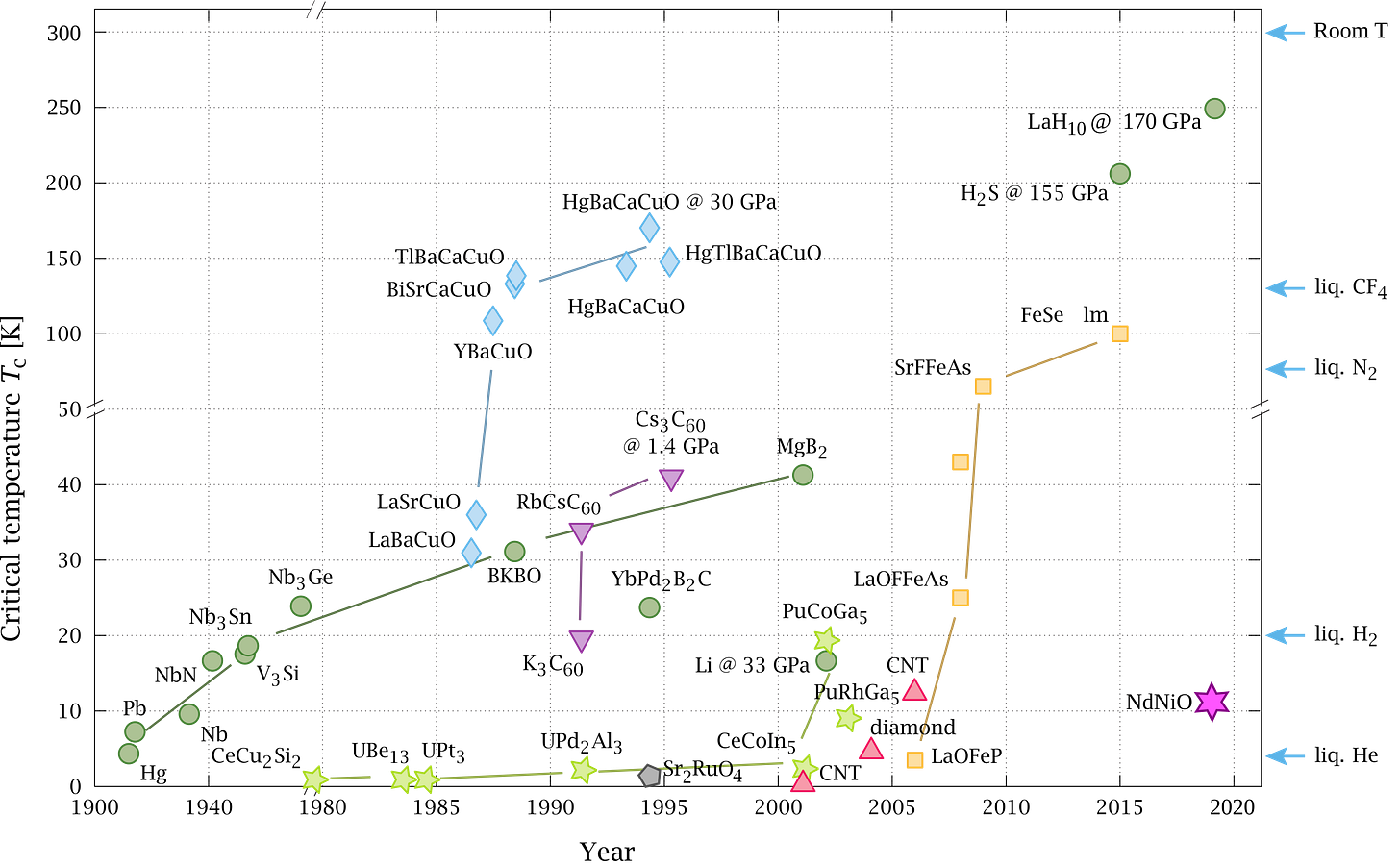
In order to prove that you have a superconductor, you need to show three things:
Zero electrical resistance: Resistance that sharply falls to undetectable levels below a critical temperature (Tc), a critical magnetic field (Hc), and a critical current density (Jc) flowing through the material. You typically measure this with a four-point probe.
Meissner effect: The material expels magnetic fields. The simplest way to show this is by magnetic levitation (see below), but there is a fancier tool called a SQUID magnetometer that can measure this effect quantitatively.
Flux quantization: When you have a ring of superconducting material in a magnetic field, the field flowing through the middle can only be a series of exact numbers (x, 2x, 3x, etc. – not x, 1.1x, 1.2x, etc.). If this sounds a bit wonky, trust your gut. You also measure this using a SQUID magnetometer.
In the LK-99 preprint, the researchers published the following:
Zero-ish electrical resistance: They showed a sharp drop in resistance, but not to undetectable levels, and their measurement method (2-point, not 4-point) lacked precision. This wasn’t a slam dunk, but you could imagine the issues in the data arising from impurities or lack of access to the right tools — things that can be corrected in subsequent experiments.
Meissner-like effect: They showed partial magnetic levitation (see below). This result wasn’t perfectly clean either, and could have meant that either A) the sample was a superconductor with some impurities, or B) the sample was a diamagnet or ferromagnet rather than a superconductor.
Flux quantization: Not attempted.
In short: The preprint showed a very incomplete set of evidence, but the results were exciting enough that you couldn’t dismiss them out of hand. You could also imagine that the researchers felt some pressure to get this result out there ASAP. They had already filed for patent protection, and this kind of discovery has Nobel Prize implications. You don’t see a new floating rock every day!

Just as exciting was how pedestrian a material LK-99 was. Its complicated-looking formula – Pb9Cu(PO4)6O – belied a simple compound made of abundant materials: lead, copper, and phosphate. Its crystal structure was nothing out of the ordinary. There were no rare earth supply chains to deal with. It was easy to imagine scaling up production without breaking the bank. And it was also plausible that despite its simplicity, nobody had looked at it seriously. The periodic table is vast, and there are lots of materials with no known uses. Case in point, this material had been sitting on the shelf since 1999!
In the 2001 comedy Rat Race, six guests at a Las Vegas casino are randomly plucked from the casino floor by the quirky billionaire owner. He offers them each a chance to win two million dollars. All they have to do is win a race against the other five — from Las Vegas to Silver City, New Mexico. In the Silver City train station, the money is sitting in a duffel bag in locker #001. There are no rules, just do whatever it takes to get there. He gives each of them a key and says, “Go!”
At first, this motley crew — which includes Whoopi Goldberg, Seth Green, and (of course) Rowan Atkinson — is skeptical, even dismissive. But on the way out of the casino, there’s a moment where they all look at each other, realize it’s real, and then start scrambling over each other to get to the airport. Hilarity ensues. I may have watched this movie a few too many times.
What happened in the days following the LK-99 preprint felt like an internet version of that scene. After the initial shock, a rag-tag assortment of academics, startup engineers, and (of course) Russian catgirls all started scrambling to replicate LK-99. It didn’t matter who you were before that day; all that mattered was getting to the truth by whatever means necessary. Precursors were rush-ordered, furnaces were commandeered, memes were posted. This is what my X feed looked like:
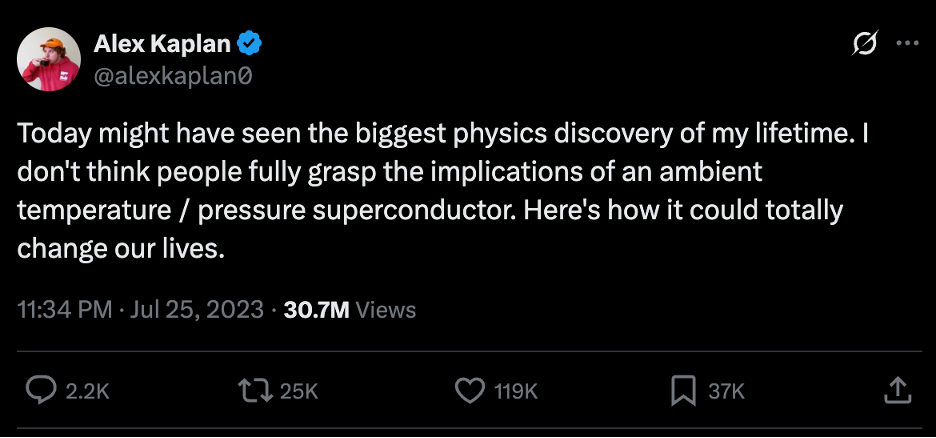
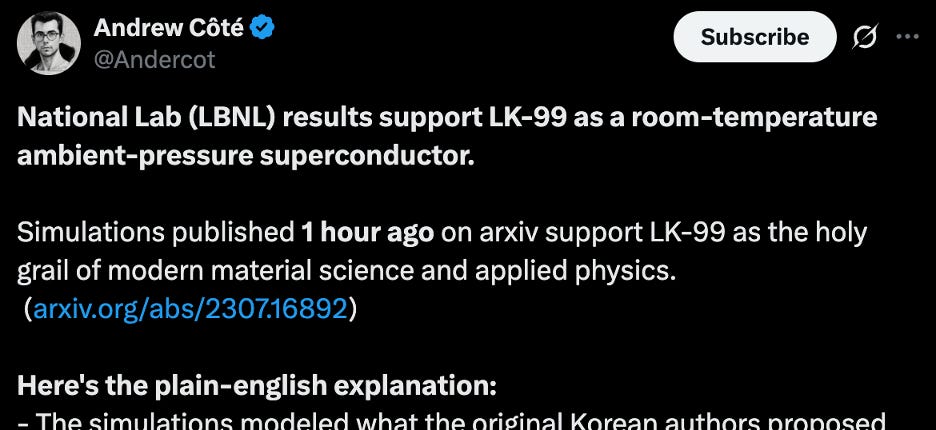
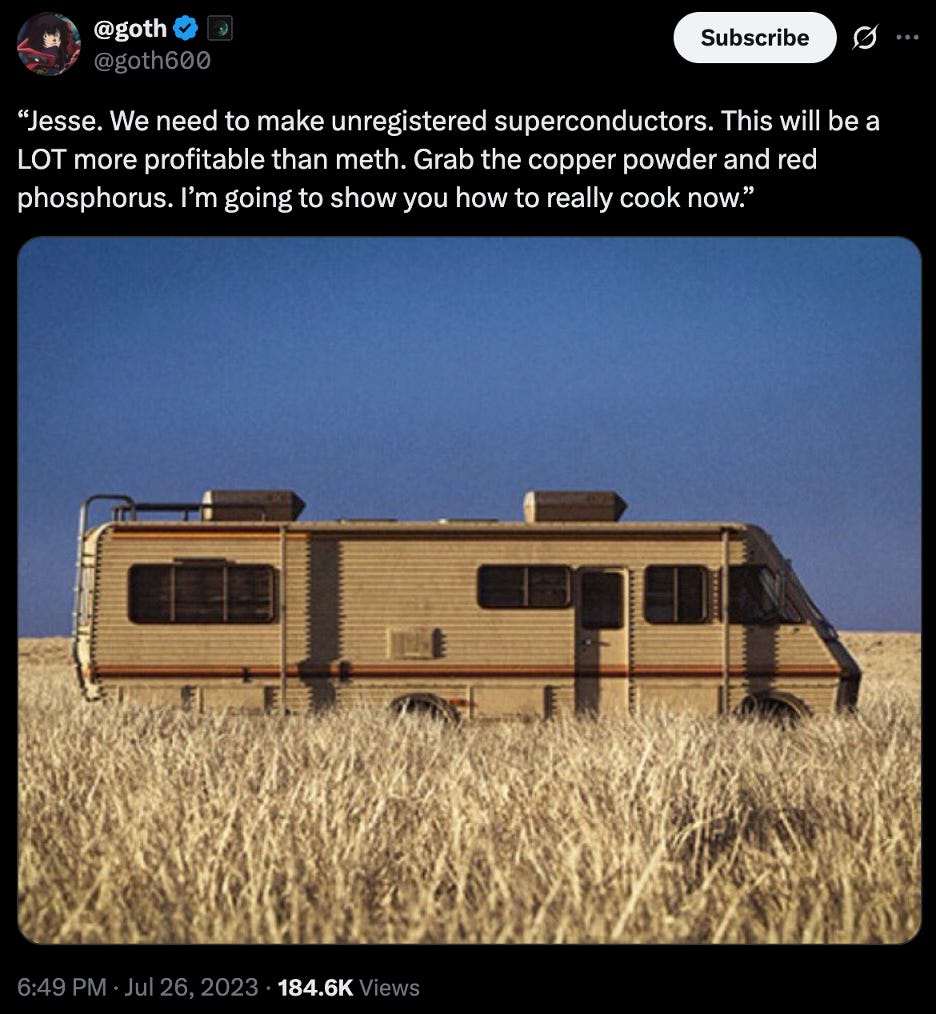
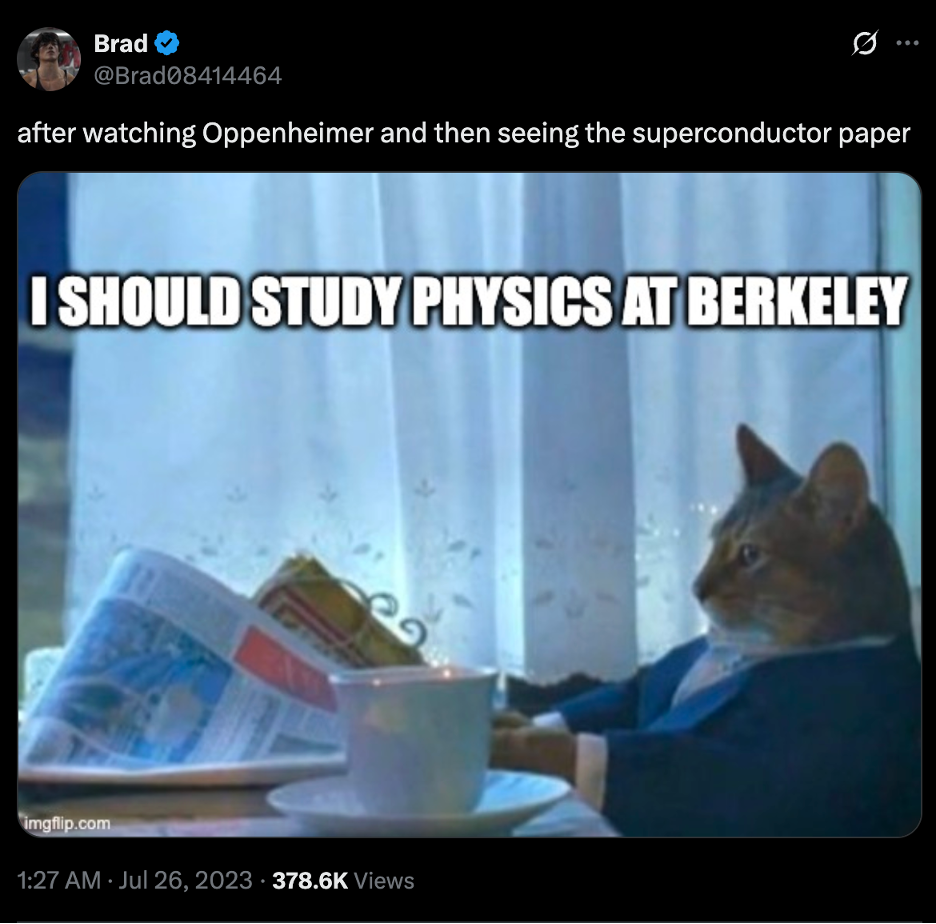
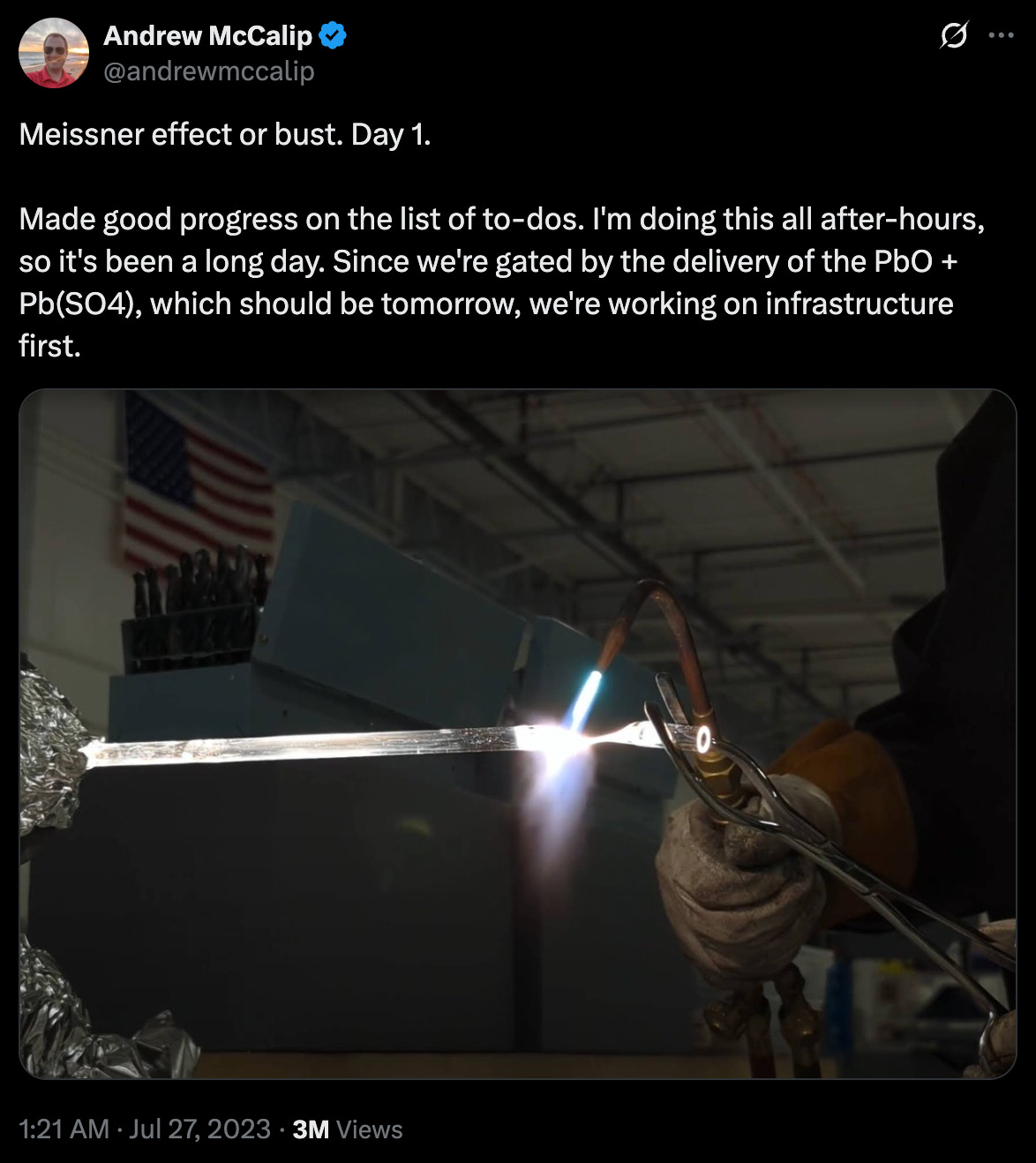
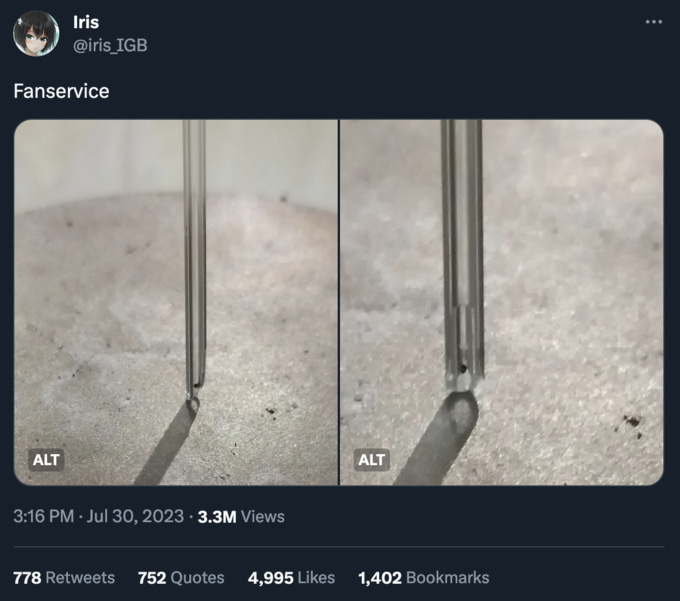
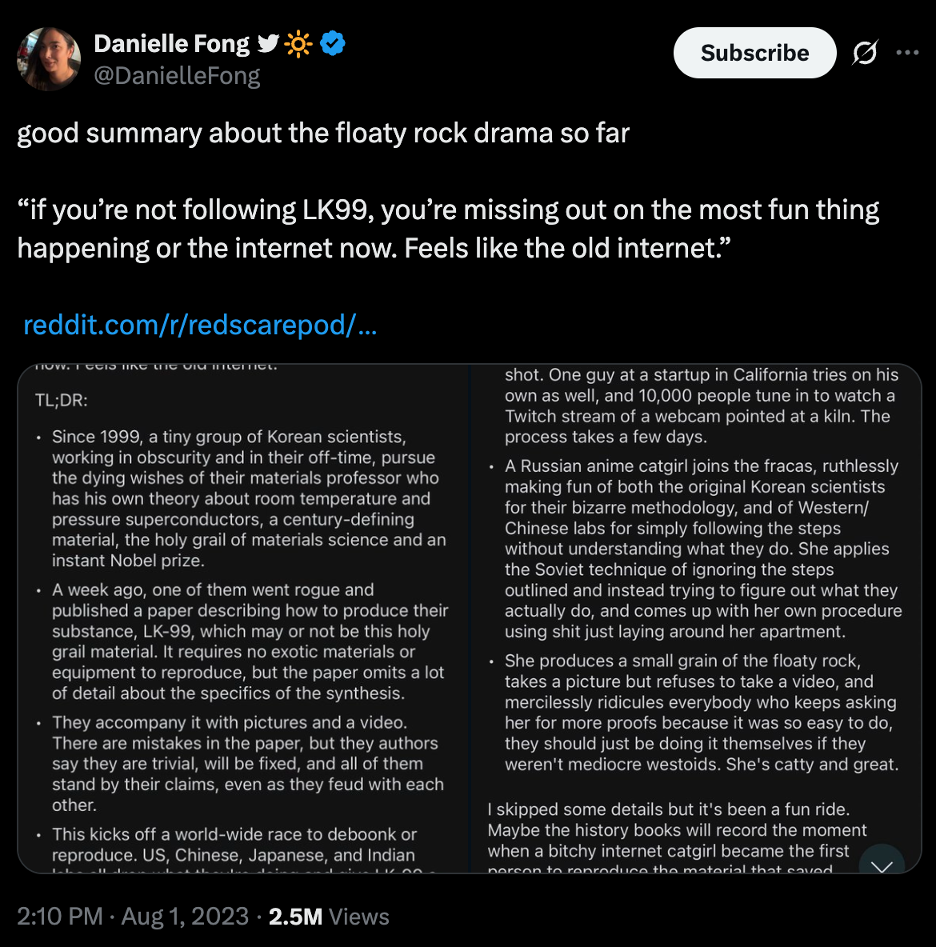

It was an internet speedrun of the scientific method. It was also a rare case where the viral thing on the internet … mattered! It was very fun.
Sadly, in the end several groups conclusively found that LK-99 was not a superconductor. The initial observation of levitation was explained by mere ferromagnetism, and the observed drop in electrical resistance was explained by copper sulfide impurities present in the sample.
Just as (spoiler alert) locker #001 in the Silver City train station was empty, LK-99 was not the superconductor of our dreams.
The end result was unfortunate, but the journey wasn’t for nothing. Three lessons stick with me:
It’s possible to learn important things in weeks, not years. Widespread access to relatively inexpensive scientific equipment brought more human capital to the problem and helped uncover the truth faster.
A diversity of institutions creates a healthy ecosystem. The academic community has been researching HTS for decades, and I have to say, the field feels stagnant versus what it could be. Did we forget that there’s a Nobel Prize and trillions in value on the line? LK-99 revealed that there’s a ton of human capital on the sidelines waiting to jump in, and live-tweeting the scientific method actually accelerated progress. Shortly after the episode, Ben Reinhart articulated this point extremely well:
All sorts of players played important roles in the LK-99 saga: the idea originated at an international institution, had interest driven by folks at private companies, pseudonymous individuals on the internet, and national labs, with people at name-brand American academic institutions closing the book on it (or at least finishing this chapter.) While “meme science” … might criticize institutional science for killing ideas and the institutional science might criticize the meme science for being irresponsible and playing fast and loose, the fact is that this is what progress looks like. Without the fast-and-loose enthusiasm of the memers, institutional science would probably have just ignored the whole thing. Now we collectively have more knowledge which (might) be leveraged to eventually get powerful new materials.
Surely there are other RTS candidates out there waiting to be discovered? There’s no fundamental reason that some other material couldn’t be the one.2 We’ve now observed superconductivity in materials as diverse as metals, ceramics, and strange pressurized phases of matter, and we continue to discover new ones. For example, a team at Stanford and SLAC discovered nickel oxide-based materials that seem to show superconductivity at ambient pressure and low temperature. Another team across Europe and South America announced ambient pressure, room temperature superconductivity in a graphite-based material, though it’s not clear how real the result is.
So what next? I think we’re just scratching the surface. If RTS works, it will matter, and for that reason I think we should be doubling down on discovery efforts.
Okay, fine, there’s a good reason that academia hasn’t figured it out yet. This is a tall order! The solution space is almost the whole periodic table, and we don’t know if an RTS will contain one element or twelve. There are lots of potentially viable combinations, but the search is not at all constrained.
I like the approaches that ARPA-E and DARPA take when faced with problems like these: identify the metrics that matter, identify the key scientific questions we don’t have answers to, and then fund a portfolio of shots on goal. If you don’t nail it with the first portfolio, iterate on your approach and fund a new portfolio. My sense is that we should be using these agencies to breathe fresh life into our R&D efforts. I also wonder if there’s a private FRO to be built.
If I were in charge, I’d put — finger in the wind — about half of our effort toward improving our theoretical framework, and the other half toward using modern tools more effectively: quantum computing to supercharge simulations, automated synthesis and characterization to iterate faster, materials informatics to streamline lab-wide efforts, and AI tools to handle some of the grunt work.
I would be remiss as a hardtech VC if I didn’t mention that there is also a growing group of AI-driven materials discovery startups: Lila Sciences, CuspAI, Altrove, Kebotix, and seemingly more by the day. These are intriguing, but most seem to be pursuing improvements to existing technologies that (IMHO) don’t have runaway potential: sorbents for carbon capture, catalysts for electrolyzers, magnetic materials, etc. Even if technically successful, commercialization in these fields is notoriously slow and driven by incumbents. That makes for a difficult startup journey. So why not shoot for a true game-changer in a field with no incumbents?
There’s really a lot to be done here. If you’re interested in superconductor discovery, please send me a note.
Elsewhere:
Thanks for reading!
Please share your thoughts and let me know where I mess up. You can find me on LinkedIn and X.
In the HTS materials that we do have, superconductivity arises from fragile quantum states in complex crystals. For example, in an undergrad chemistry course, I made a superconductor called YBCO. Its chemical formula is YBa2Cu3O7−x. The “x” is notable because in order to be superconducting, YBCO needs to have a few, but not too many, oxygen atoms missing from its crystal structure. Why? We don’t really know, but it has something to do with CuO2 planes within the crystal, something to do with doping, and something to do with magnetic interactions within the material that give rise to Cooper pairs, special pairs of electrons that move without resistance.
A theoretical study published this year confirmed that room temperature superconductivity is still possible.

This is excellent—I couldn’t agree more. As David Deutsch said, ‘Anything that is not forbidden by the laws of physics is achievable, given the right knowledge.’ If there’s a solid theoretical framework behind RTS (as there appears to be), then those of us who dare to dream should be racing to discover that knowledge!